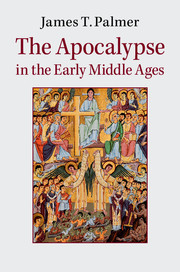Book contents
- Frontmatter
- Dedication
- Contents
- List of figures
- List of maps
- Acknowledgements
- List of abbreviations
- Maps
- Introduction
- 1 The end of civilisation (c. 380–c. 575)
- 2 The new urgency (c. 550–c. 604)
- 3 The ends of time and space (c. 600–c. 735)
- 4 Pseudo-Methodius and the problem of evil (c. 680–c. 800)
- 5 Charlemagne, pater Europae (c. 750–c. 820)
- 6 A Golden Age in danger (c. 820–c. 911)
- 7 The Year 1000 and other apocalypticisms (c. 911–c. 1033)
- Conclusion
- Select bibliography
- Index of manuscript references
- General index
- References
Introduction
How the world ends
Published online by Cambridge University Press: 05 November 2014
- Frontmatter
- Dedication
- Contents
- List of figures
- List of maps
- Acknowledgements
- List of abbreviations
- Maps
- Introduction
- 1 The end of civilisation (c. 380–c. 575)
- 2 The new urgency (c. 550–c. 604)
- 3 The ends of time and space (c. 600–c. 735)
- 4 Pseudo-Methodius and the problem of evil (c. 680–c. 800)
- 5 Charlemagne, pater Europae (c. 750–c. 820)
- 6 A Golden Age in danger (c. 820–c. 911)
- 7 The Year 1000 and other apocalypticisms (c. 911–c. 1033)
- Conclusion
- Select bibliography
- Index of manuscript references
- General index
- References
Summary
In 557 the great imperial city of Constantinople was devastated by an earthquake. Here was a city founded two hundred years earlier to be a truly Christian place, at the time under the dominance of the powerful and long-lived emperor Justinian I (r. 527–65). But, as the monumental Hagia Sophia built by the emperor partially collapsed, people panicked. Rumours circulated that the world was nearly at its end and self-proclaimed prophets caused terror by preaching about worse things to come. Had Christ himself not foretold of earthquakes in the Last Days (Matt. 24.7; Mark 13.8; Luke, 21.11)? Agathias, a lawyer in the city, despaired at how easily people had been wound up by such nonsense, which he found often accompanied these kinds of disasters. He also noted that the people of the city reformed their lives: ‘suddenly all were honest in their business dealings, so that even public officials, putting aside their greed, dealt with lawsuits according to the law.’ Hymns were sung, gifts were given to the Church, people lived better lives. The fear of imminent judgement had reformed society – or at least would have done, had people not reverted to their old ways as soon as things had calmed down (Proverbs 26.11).
Agathias’s story treats us to a drama which is resoundingly human and modern despite its distance to us in time. In many crises, big or small, people are unsettled and seek to change their lives, as they hope to understand the higher reasons for what is going on. Apocalypticism has repeated, if not enduring, resonance for human societies. It reveals much about how people understand the world and their place in it. As Frank Kermode observed, it is almost natural for human beings to anticipate endings when they tell stories about the world. The way a narrative resolves can legitimise or subvert the route there, so a life of suffering can be made good by a finale of peace and joy but it can be made more tragic if the ending resounds with hopelessness, fear and torment. And since everyone has an ending, even if the end of time or the world is too abstract to conceptualise fully, then it really is a universal in human experience. Johannes Fried expressed this in no uncertain terms for the Middle Ages: ‘the end of time was the fundamental interpretative category for all humanity, belief, knowledge and action, even if it was not always and by everyone and in every deed made explicit.’ Agathias may have shaken his head at the popular response to the earthquake, but he understood all too well that he was observing a common human dynamic, framed in this case by (mis)understandings of scripture.
- Type
- Chapter
- Information
- The Apocalypse in the Early Middle Ages , pp. 1 - 24Publisher: Cambridge University PressPrint publication year: 2014



